
park
Committed to Community

Since its founding in 1991 Carmel Clay Parks & Recreation has been committed to being a strong and supportive community partner. Over the last few months — like you and the world beyond we have navigated unprecedented times and are learning and finding new ways to support our team and the public.

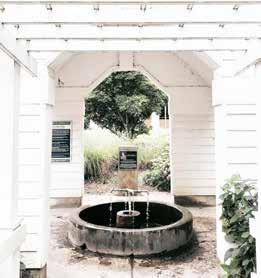
What we do know is this: We are stronger now than ever before. Our team has seen everyone join together to practice patience, understanding and to share encouragement. This edition of Park Conversations is all about the value of community. It explores the many ways Carmel Clay Parks & Recreation is here to support you. Each path to wellbeing is unique whether that is building you up on your fitness journey, encouraging you to achieve your goals through recreation programming, or developing sustainable parks for future generations. We want you to know that now, more than ever, we are committed to you. We hope as you read these stories you find yourself inspired.
And as always, don’t let the conversation stop here — we hope you’ll share your story with us.
2 park conversations
Regards,
Michael W. Klitzing, CPRE Director of Parks and Recreation
We encourage you to share your stories!
contents 4 8
10 12 14
04 THE PATH TO INDEPENDENCE
Over the last decade, Michael and Jessica Sharkey have been on their own path to independence. Adaptive programming at the Monon Community Center has helped them along the way.

08 REIMAGINING FLOWING WELL PARK
With a national park feel right here in Carmel, people are coming from far and wide to visit for the experience.
10 HELP OUR NATIVE HABITATS
Make a difference in your own backyard with tips from our Natural Resources team about eradicating invasive species!

12 GROWTH THROUGH COMMUNITY
The Monon Community Center offers amenities and a fitness community to call home.
14 TEACHING TAKES A GLOBAL PATH
Dena Osting has taught all around the globe, but her journey brought her back to where she started making a difference in her hometown.

carmelclayparks.com 3
SPRING 2020
INDEPENDENCE PathTHE
TO
4 park conversations
Michael Sharkey reaches over to hold his wife Jess’s hand, nods his head, smiles and lets her know he is there to support her as they share their story. His kindness and encouragement are palpable. Beyond the basic life skills Michael has learned himself through unique adaptive programing at the Monon Community Center (MCC), he’s also developed an understanding of the importance and value of a community that provides a safe and supportive environment to thrive and gain confidence. The path to independence for both Michael and Jess has not always been easy to navigate, but it is one that led them to something we all want to feel — included.



carmelclayparks.com 5
Michael’s journey started over 10 years ago when he attended Teen Night Out at the MCC. The program creates an inclusive social environment for teens with disabilities to share dinner, swim, play basketball, hang out in the gym, develop friendships and so much more.
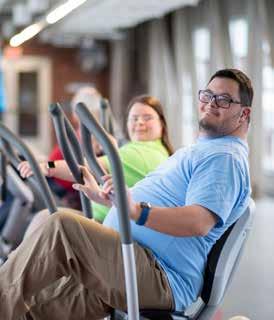
“I met a lot of people through programs at the MCC who are now my good friends,” shares Michael. “I’m a pretty active guy and it gave me a fun and safe space to be myself and to work on the skills it takes to develop connections and relationships. I met Jess there and one of my best friends, Dan.”
The MCC soon became a “home away from home” for Michael and many others who participate in adaptive programs geared toward individuals with disabilities. Adaptive programming is founded on the belief that everyone from toddlers to adults — should be able to participate in leisure opportunities that allow for performance at a high level. CCPR offers a wide range of program types including swim lessons, yoga, and strength training to culinary, current events, and creative art classes all which comprise one of the largest adaptive programs available in the state.
multiple days in a week. Once I started walking on the track and working out with my friend Dan, I realized that I was pretty strong, and I liked staying in shape. I’ve even run a 5K. It felt so great to cross the finish line!”
CCPR provided tools that assisted Michael in setting and attaining goals like running a 5K or working a job. But Michael is one of many who have been positively impacted by CCPR’s adaptive programs. By assessing community needs and developing curriculum around these needs, CCPR has built a growing adaptive community and along the way fostered an organization-wide culture of inclusion. Michelle Yadon, Monon Community Center Recreation Services Manager, shares this is a big part of what makes adaptive programming at the MCC so successful.
I met a lot of people through programs at the MCC who are now my good friends — I am a pretty social guy and it gave me a fun and safe space to be myself and to work on the skills it takes to develop connections and relationships
“Jess and I took a cooking class and that really helped us become more independent in the kitchen and we take a cycling class together every week,” Michael says. “I’m here at the MCC frequently, sometimes for
“Michael and Jess both have jobs. Jess works at the MCC KidZone and Michael works in the hotel industry. They are married, stay physically active, know what keeps them healthy, and continue to develop friends and relationships and add new experiences to their life-skill set. Just like all of us, they set goals for themselves and work hard to make those dreams and goals become reality. CCPR helps provide that safe and supportive learning community to help them become all they can.”
This past spring, Michael played the lead role in CCPR’s Barrier-Free Theatre performance. This annual play created by the actors around a topic of their choice is another opportunity for Michael, Jess and other individuals with and without disabilities
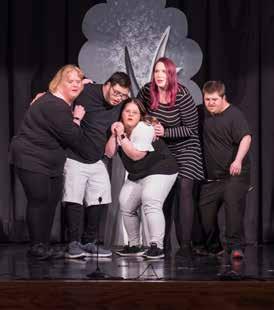

6 park conversations
much more than their diagnosis and they are capable of everything from memorizing lines and decorating sets to working together as a team to bring joy to others.
“Beyond his mentorship role in the play, Michael has played a huge role in working with me on what type of programming is wanted and needed within the Carmel community,” says Yadon. “He’s really emerged as a leader at the MCC and often comes to me with class suggestions or things he is interested in that translates to a more global application of what classes will be helpful to all individuals in our adaptive programming. He’s someone I rely on when considering what we should offer and what will help our participants thrive.”
Prior to getting married, Michael approached Yadon on how he could learn to be a good partner and support system for his soon-to-be bride Jess. “I wanted to be a caring and good husband and Michelle helped teach me some life lessons. I knew it wasn’t going to be like learning a work skill but more of how I could just be considerate of someone else’s needs and feelings and how we would work together as a husband and wife.”

Jess agrees that the MCC has been a community where she has learned and grown through participation in programs, membership and eventually her job as an attendant in KidZone the childcare facility located inside the MCC for members. She enjoys nothing more than engaging with the kids.
CCPR provides abounding opportunities for Michael and Jess and for so many others in the community. Opportunities to become contributing and working citizens, to stay healthy and strong, to learn to cook, sing, dance and become socially aware and independent. Opportunities to be included in the day-to-day world around them and to contribute value to their community.
“I’m so glad I took that first step over 10 years ago and came to Teen Night Out at the MCC,” Michael shares. “I’ve learned so much and it has changed my life.”
Finally, Michael takes his hand off Jess’s and continues to smile at her with an “I’m here for you” look in his eye. For Michael and Jess, this path to independence and happiness is just the beginning.
CCPR is always looking to expand their focus on inclusion and adaptive offerings. If you have ideas or feedback, please let us know by visiting carmelclayparks.com/inclusion.
carmelclayparks.com 7
REIMAGINING PARK
Now that he’s retired, the place you’ll often find Ed Shaughnessy is in Flowing Well Park, perched along the banks of Cool Creek. He’ll have a fishing pole in hand, and an extra in his Jeep®. While he wouldn’t call himself an expert, he loves to share the basics of fishing.
Shaughnessy has completed the DNR Go FishIN Crew Captain class a fishing education program and keeps extra fishing gear on hand. Oftentimes park visitors will spot Shaughnessy fishing and ask if he can teach them some basics. He’s always happy to help.
“For a long time, I thought Flowing Well Park was the well and the parking lot and that’s it. My dad, who lived on Indy’s east side, would drive to Carmel to get water from the well” says Shaughnessy. “I didn’t know there was a trail back through the park, let alone a creek for fishing until a few years ago when I found it listed as a park feature on the CCPR website. Now that I live in walking distance, there are some days I’m there fishing for hours.”
Flowing Well Park is frequented by those who enjoy fishing, gathering water from the well, walking the trails and stomping in the creek. Last year alone the park had more than 200,000 visitors. The love for this local treasure has remained strong.
The History of Flowing Well Park

Before Flowing Well Park was a park — and before it was even part of Carmel it was a piece of land along Cool Creek in Mattsville, Ind. In 1904 the well was accidentally discovered by drillers on the hunt for natural gas. As you may have guessed, it wasn’t natural gas they found, it was an artesian well.
For years following its discovery the well was just a pipe sticking out of the ground on the land of Charles L. Williamson. In 1926 Williamson donated the well for public use and a concrete structure was built around the well.

Fast forward nearly 70 years to 1991 and the well and surrounding land were donated to then-newly established Carmel Clay Parks & Recreation. Three years later in 1994, Flowing Well Park opened as CCPR’s first public park.
Thanks to the Land & Water Conservation Fund (LWCF), Carmel Clay Parks & Recreation received a $75,000 matching grant and in total invested upwards of $150,000 into the park. This money went toward trails, bridges, signage, and property acquisition. One of the most important aspects of the grant is that the land will always be protected as a recreational and natural resource for the community.
8 park conversations
Photo provided by Carmel Clay Historical Society
The Future of Flowing Well Park
With funding from the Clay Township Impact Program, this year, the park will undergo further transformation and will remain accessible for generations of creek stompers, water gatherers and explorers to come.

“The updates will make Flowing Well Park more functional for the everyday visitor,” says Michael Allen, Carmel Clay Parks & Recreation director of Parks & Natural Resources. “We are not only improving existing recreational opportunities, but we are expanding access to trails. To me, beyond being good stewards of quality habitat, the next most important thing is providing the community access to understand the value.”
Upgrades to Flowing Well Park include Cool Creek bank restabilization, restrooms, parking lot expansion, and updated interpretive signage and trails. The design process for Flowing Well Park’s updates began in 2019.
CCPR is working closely with Schmidt Associates to design and engineer the updates. In November 2019 CCPR held community input meetings to share slated updates and receive feedback from residents about their wants, needs

and priorities. The investments made in the midnineties are largely how the park has remained, and the upgrades will ensure the park remains an asset to the local community, wildlife and habitat for years to come.
“The park offers the feeling of being out in a state park, but it’s right here in the middle of Carmel,” Allen says. “Once you’re here, you can forget that 116th street is just to the south of you.”

Shaughnessy is looking forward to the changes coming to the park this year. He has plans to bring his kids and his grandkids to Flowing Well Park to fish making it four generations of Shaughnessys who have enjoyed the park.
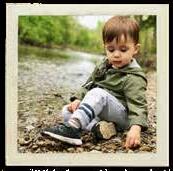
But it’s not just the fish sunfish, creek chub, large and smallmouth bass that keep Shaughnessy coming back to the park nearly every day. He said his favorite story is one that repeats itself time and again it’s the people he meets and the memories he’s made. It’s seeing the smile on a kid’s face when they catch their first fish, regulars filling their water jugs at the well, or a family out exploring. Thanks to Reimagining Parks, these memories will continue to be made for years to come.

In the spring of 2020, the park will close to ensure public safety as CCPR begins implementing updates. The park is projected to reopen in late 2020 or early 2021. Stay up to date by visiting carmelclayparks.com/reimagining-parks.

carmelclayparks.com 9
The updates made possible by the Clay Township Impact Program will make Flowing Well Park more functional to the everyday visitor.
Community members share their experiences @carmelclayparks
Ed Shaughnessy
@amanda.merriweather @brittany.cummings @mattclark @amanda.merriweather
HELP
BITATS

invasive species? Around Carmel Clay Parks & Recreation, these are buzz words. We talk about them a lot. That’s because we have a big goal to drastically decrease the invasive species in our parks and help our neighbors remove invasive species from their own backyards.
What are invasive species, or as we often refer to them invasives? According to the U.S. Department of Agriculture, an invasive species is any type of organism that isn’t native to a certain area. In our case, that simply means it isn’t from Indiana. When invasive species are introduced to an ecosystem, they have the potential to cause harm to the environment, the economy, and to human health.
Invasives are prevalent in our parks, neighborhoods and our own backyards and are more hurtful than good. Education is key to understanding how to identify and then eradicate invasives and restore original natural habitats. To help inform the community CCPR hosts nature
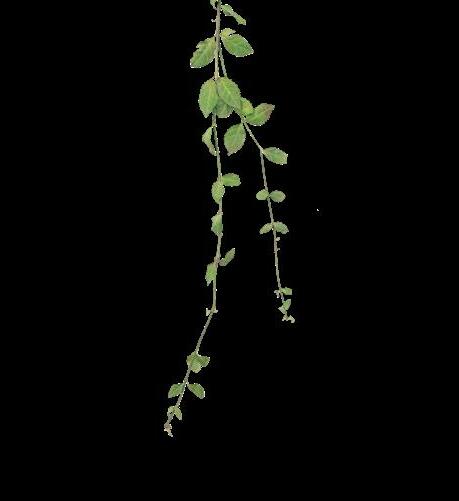







programs and volunteer events around topics like invasive species removal.
“Invasive species don’t follow property lines, and an invasive species planted in a neighbor’s yard can soon become a problem in the parks, and vice versa,” says Michael Allen, CCPR Director of Parks & Natural Resources. “To be good land stewards and neighbors, the best thing we can do is educate ourselves so we can make the best decision for our land and the wildlife and plants that call that land home. I’m excited that we’re having these conversations more and more. We’re glad to be a resource for our community and the parks and natural resources team is always here to help!”
10 park conversations
Invasives have no real value in the ecosystem.
They can sometimes provide habitat but rarely provide food sources for animals. An example of this is bush honeysuckle. Birds eat the berries on bush honeysuckle but the berries provide little to no nutritional value.
Invasives spread rapidly and outcompete native species.
Asian carp, for example, cause serious damage to native fish populations by battling for food and space. Some terrestrial invasive plants, like garlic mustard produce an enzyme that kills native species around them.
Invasive species generally have no natural predators.
All of these factors combined lead to invasives outcompeting native plants and animals. Ultimately, this leads to a loss in biodiversity and economic loss.
So, now we know why invasives are bad for us and our native habitat. But what can be done? The best way to stop the spread of invasive species is prevention. If you have invasive species in your backyard, here is what you need to know about them and what you can do to battle these backyard nuisances:
Understand which species you’re dealing with.
This is crucial because best practices vary depending on which species you are removing. For example, some are easy to pull by hand like garlic mustard, while others like bush honeysuckle need to be pulled by the entire root. A useful tool for learning more about different species and how to remove them is the Southern Indiana Cooperative Invasives Management website (SICIM.info).
Be patient.
A challenge for managing invasive species is that it can’t always be done in one afternoon. It may take months or years to completely rid your yard of invasive species. That’s why it’s important to be patient, monitor your progress and be persistent.
Knowledge is power.
If you have an invasive species in your backyard, consider reporting it. The best way to report invasive species is through EDDmaps phone app, a real-time tracking of invasive species occurrences. This helps you and others in the community understand which invasives are most prevalent in our community. You can also attend a CCPR nature or volunteer event to learn more about natives and invasives and take that knowledge home with you.
Replace invasives with natives.
On your next trip to the greenhouse or nursery, buy native plants rather than non-native or invasive plants. This will help improve wildlife habitat in your backyard.
Join the fight against invasive species—volunteer with Carmel Clay Parks & Recreation. We have several events planned to help remove invasive species in our parks. Learn more and sign up at carmelclayparks.com/volunteer.

carmelclayparks.com 11






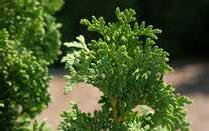

12 park conversations SWAP! PLANT THIS F THIS:INSTEAD MAKE THE SERVICEBERRY White springflowers, colorful fall foliage and edible fruit Bright pinkflowers, mildewresistant SUMMER PHLOX DAME’S ROCKET Bright pink and white flowers Red in the fall with red berries RED CHOKEBERRY BURNING BUSH Red in the fall with red fruit Information courtesy of Midwest Invasive Plant Network, MIPN.org. Ready to make the swap in your yard? The ecology of your property — soil type, light and hydrology will help determine which native plants you should purchase. Here are some common invasive species in the local area along with a native alternative. BUSH HONEYSUCKLE Fast growing with red fruit that attracts wildlife Dense cover and berries make for great bird habitat EASTERN ARBORVITAE COMMON BUCKTHORN Used as a hedge or border plant
CROSSWORD PUZZLE
carmelclayparks.com 13
1 2 3 4 5 6 7 9 10 11 12 8 DOWN: 2. Species indigenous to a given region or ecosystem 3. One of the three things that make up the ecology of your property 5. A person
their
skills to help Carmel
Recreation 6. The diverse plants and wildlife that make
a habitat 8. A
tracking
invasive species 9. Animals,
battling
food
space ACROSS: 1. The best way to stop the spread of invasive species 4. One
you
partner
Carmel
care
section
park
trail 7. ______ produce red berries that provide birds little to no nutritional value 10. Any type of organism that isn’t native to a certain area 11. An organism’s natural home or environment 12. A useful website for learning more about different species and how to remove them 1. Prevention 2. Native Species 3. Hydrology 4. Adopt-A-Park 5. Volunteer 6. Ecosystem 7. Bush Honeysuckle 8. EDDmaps 9. Asian Carp 10. Invasive Species 11. Habitat 12. SICIM ANSWER KEY:
who gives
time and
Clay Parks &
up
phone app that allows real-time
of
like this invasive fish, cause serious damage to ecosystems by
with native species for
and
way
can
with
Clay Parks & Recreation to
for a
of
or

Living the Life
Since he was a kid, Vanderhagen has been active. From high school varsity sports and intramural sports at Butler University to a rigorous fitness regimen today, healthy habits are an integral part of Vanderhagen’s lifestyle.
The discipline and team-mentality Vanderhagen developed from years participating in sports is reflected in his work. After college he followed in his father’s footsteps and pursued a career in finance. A few jobs and relocations later he realized he wanted to forge his own path. A job in software sales moved Vanderhagen to Chicago, where he lived his dream of “making it” in the windy city. But something just didn’t feel right. He had been having trouble sleeping, was having digestive issues, and felt low on energy. After nearly a year of doctors’ visits and assessments, he was diagnosed with Hodgkin lymphoma.
The news was hard to swallow. In Chicago Vanderhagen lived on his own, without a car, and miles from his core support group — his family. But even though his family was in another state, they were there for him. They drove up for chemotherapy appointments, visited often to help cook and clean, and his sister even buzzed his head when he started losing his hair. The illness left him physically and emotionally drained.
Having to Hit Reset
When he entered remission a few years ago he moved back to Indianapolis to be closer to family and the city he’d called home during his college years. Vanderhagen decided to set intentions for his post-illness fitness journey.

“When I hit reset on my fitness, I was coming out of my illness,” says Vanderhagen. “After six months of chemotherapy, my cardiovascular shape was horrendous. I just really wanted to come back and exceed who I was before. I needed a place with a variety of amenities and a fitness community to call home and the Monon Community Center helped me get there.”
Growth through Community
Right away Vanderhagen plugged himself into group fitness classes and now a year later he’s confident he’s tried every class at least once. “As an early riser, I’m able to start my mornings off
right,” Vanderhagen says. “I’m fortunate to have great instructors to push me because I always want to be better.”
He’s a regular in the boot camp class with Tammy Roberts and the strength classes with Michelle Longley. Vanderhagen shares he’s an overall better person because of them. “They are strong women,” he says. “They’ll push you outside your comfort zone and I find a lot of growth in discomfort. They’re very good at encouraging you at the right times.”
Tammy Roberts says she enjoys having Vanderhagen in her boot camp class because he always comes in with a positive attitude. “Mitch is one of a kind. He always encourages everyone in class to do more,” Roberts says. “It’s not unusual to see him quietly encouraging someone who might be struggling to keep up. I’ve actually seen him slow down his own workout in order to help someone else.”
Continuing to Get Stronger
Though the journey has been long and it hasn’t been easy, Vanderhagen shares that through it all he’s grown stronger mentally and physically, and truly feels he’s found his team at the MCC. He’s come to value his health, and the community that’s helped him get there. He’s learned the power of surrounding himself with people who build him up, and found joy in encouraging those around him.
“The MCC provides a community close to home and it surrounds me with people I have a lot in common with,” Vanderhagen shares. “Everyone is there to better themselves and get in better shape. It’s fun after a long day to share that commonality with people to encourage them and not only see your results but see other’s results too.”
carmelclayparks.com 15
GLOBAL PATH GLOBAL PATH Teaching takes a
Where in the world has Dena Osting been? Well, to tell you the truth — a little bit of here, there and everywhere. Her passport is filled with colorful stamps documenting her global teaching and leisure travels. In recent years she’s been working and sharing her vast educational experience and knowledge in the United Arab Emirates, specifically in Abu Dhabi, a far cry from her days growing up in Indianapolis and her more recent move back to Carmel. Osting says her work with the Carmel Clay Parks & Recreation Extended School Enrichment program and the kids she sees every day is just as rewarding as her interaction with kids on the other side of the globe. Learning, caring, collaborating, and including all is a universal language for her.
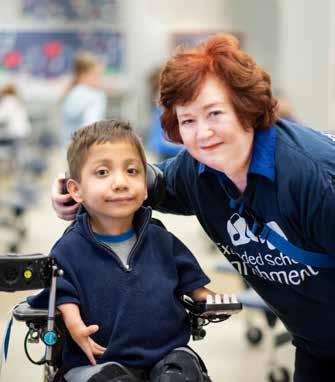
16 park conversations
“I grew up in the Indianapolis area but moved to Wisconsin soon after marrying my husband, an industrial chemist, and quickly became the mother of two small children,” shares Osting. “My husband died of cancer at the very early age of 39, and I quickly became a single mother on a single income. When finances began to get difficult, I knew it was time for me to return to school for more education.”
Osting earned degrees in education and special education and spent over 10 years working in Wisconsin developing programs for young children from birth to 8 years of age. In 2012, Osting was ready for a new challenge and began searching for a global teaching opportunity. She traveled to Chicago and was interviewed for a teaching position in Abu Dhabi. While many might fear such a drastic change in teaching and cultural environments, Osting embraced the adventure and the opportunity to help children, no matter where they are located or what disabilities they have, to develop the best plan for their educational progression and inclusion.
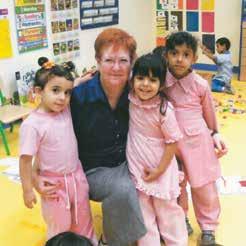
“I lived in a nice apartment in the city and was driven about an hour-and-a-half out into the desert each day to work,” Osting says. “I soon realized that the children with disabilities had not been integrated into the school’s daily routines. I worked mostly with kindergartners some of them blind, without all their limbs or on the autism spectrum figuring out a plan to get the students up to speed and what would be required to do so. It really wasn’t any different than it was working in the United States. While some of my teaching colleagues were not so enthusiastic, I wanted to be a part of the culture. I dressed, ate and was respectful of their everyday life. I was totally immersed in the culture.”
Osting’s time in the Emirates allowed for her to travel extensively when she had a break from teaching and she took full advantage of that perk traveling to China, India, Egypt, Ireland and Sri Lanka. The teacher became the student as Osting visited several different countries and experienced each of their unique cultures and physical beauty. While abroad she learned as much as she could about each of her travel destinations.
ents in India.
achingstud

In 2018, after working for over six years abroad, Osting returned to Carmel to take care of her mother who was ill. She was grateful to have had time with her mother before her passing, and the move back allowed her more time with her own family as well. However, Osting soon found herself wondering what the next “destination” should be for her lifelong teaching adventure. She didn’t have to travel far to find it.
“I’ve been working Monday through Fridays at the after-school portion of the ESE program and I’ve fallen in love with the kids and everyone I work with,” Osting says. “I’m not in a teaching role per se, but I bring all of my knowledge and experience with me to work every day, and I’d be lying if I didn’t say the kids and the people I work with don’t teach me a little something new, too. Our work team ranges in age from high-schoolers to folks older than I am but we seem to blend together to bring a sense of acceptance, care and inclusion to all the kids.”
The life travels of Dena Osting have brought her right back to where she started. Through the years, she’s gathered some amazing stories and experiences. Now, she’s able to share those travels with some very lucky kids each afternoon. “You don’t always know why you are going down a specific path, all you can do is soak up the adventure along the way.”
Denate
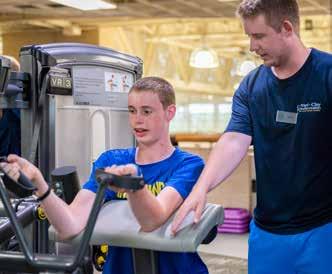




Community Center 1195 Central Park Dr West Carmel, IN 46032
Community Center 1235 Central Park Drive East Carmel, IN 46032 FIND YOURAdventure $7 for youth/seniors and $10 for adults. THE WATERPARK SEASON BEGINS SATURDAY, MAY 28 AT 11AM! Visit carmelclayparks.com purchase WATERPARK* *THE WATERPARK IS INCLUDED WITH MONON COMMUNITY CENTER MEMBERSHIP Residential Customer PRSRTSTD U.S.POSTAGE PAID Berne,IN PermitNo43 carmelclayparks.com COMMITED TO THE HEALTH + WELLBEING OF OUR COMMUNITY
Monon
Monon


















































